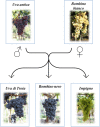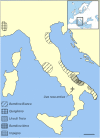The molecular characterization by SSRs reveals a new South Italian kinship and the origin of the cultivar Uva di Troia
- PMID: 27652135
- PMCID: PMC5023643
- DOI: 10.1186/s40064-016-3228-8
The molecular characterization by SSRs reveals a new South Italian kinship and the origin of the cultivar Uva di Troia
Abstract
Vitis vinifera L. varieties were spread through cuttings following historic migrations of people, trades, or after biological crises due to pests outbreaks. Some today's varieties could be more than a 1000 years old and, although over the centuries these varieties generated most of the remaining cultivars, their origin could be impossible to track back. The Italian grapevine biodiversity is one of most important, most likely due to its strategic position in the middle of the Mediterranean sea. Unravelling of its structure is challenging because of its complexity and the lack of historical documentation. In this paper molecular data are compared with historical documentations. Simple Sequence Repeats fingerprinting are molecular markers best suited to investigate genetic relationships and identify pedigrees. South-Italian germplasm was studied with 54 nuclear microsatellites. A family was identified, consisting of two parents and three siblings and further genetically characterized with six nuclear and five chloroplast microsatellites and described with ampelographic and phylometric analysis. Although these latter were not informative for the kinship identification. The common Bombino bianco was the female parent and the previously unknown Uva rosa antica was the male parent. Bombino nero, Impigno and the popular Uva di Troia, all typical of the south-east Italy, were the offspring. Further research showed that the Uva rosa antica was a synonym of Quagliano and Bouteillan noir, both minor varieties. Quagliano was considered to be autochthonous of some alpine valleys in the north-west of Italy and Bouteillan noir is a neglected variety of Vancluse in France. This finding uncovers the intricate nature of Italian grape cultivars, considered peculiar of an area, but possibly being the remains of ancient latin founding varieties. Consequently, intriguing new hypotheses are discussed and some conclusions are drawn, based on the peculiar geographical origin of the parents, on the distribution of the offspring, on the chance of a single, and perhaps intentional, crossing event.
Keywords: Bombino bianco; Bombino nero; Grapevine; Impigno; Kinship; Microsatellites; Quagliano; Uva di Troia.
Figures



Similar articles
-
Parentage Atlas of Italian Grapevine Varieties as Inferred From SNP Genotyping.Front Plant Sci. 2021 Jan 15;11:605934. doi: 10.3389/fpls.2020.605934. eCollection 2020. Front Plant Sci. 2021. PMID: 33584749 Free PMC article.
-
From grape berries to wine: population dynamics of cultivable yeasts associated to "Nero di Troia" autochthonous grape cultivar.World J Microbiol Biotechnol. 2016 Apr;32(4):59. doi: 10.1007/s11274-016-2017-4. Epub 2016 Feb 29. World J Microbiol Biotechnol. 2016. PMID: 26925621
-
Sangiovese and its offspring in southern Italy.Mol Biotechnol. 2013 Jun;54(2):581-9. doi: 10.1007/s12033-012-9600-1. Mol Biotechnol. 2013. PMID: 23001829
-
Vitis vinifera genotyping toolbox to highlight diversity and germplasm identification.Front Plant Sci. 2023 Apr 26;14:1139647. doi: 10.3389/fpls.2023.1139647. eCollection 2023. Front Plant Sci. 2023. PMID: 37180393 Free PMC article. Review.
-
Resurgence of minority and autochthonous grapevine varieties in South America: a review of their oenological potential.J Sci Food Agric. 2020 Jan 30;100(2):465-482. doi: 10.1002/jsfa.10003. Epub 2019 Oct 29. J Sci Food Agric. 2020. PMID: 31452209 Review.
Cited by
-
SNP genotyping elucidates the genetic diversity of Magna Graecia grapevine germplasm and its historical origin and dissemination.BMC Plant Biol. 2019 Jan 6;19(1):7. doi: 10.1186/s12870-018-1576-y. BMC Plant Biol. 2019. PMID: 30612542 Free PMC article.
-
DNA-based genealogy reconstruction of Nebbiolo, Barbera and other ancient grapevine cultivars from northwestern Italy.Sci Rep. 2020 Sep 25;10(1):15782. doi: 10.1038/s41598-020-72799-6. Sci Rep. 2020. PMID: 32978486 Free PMC article.
-
Genetic Diversity, Population Structure, and Parentage Analysis of Croatian Grapevine Germplasm.Genes (Basel). 2020 Jul 2;11(7):737. doi: 10.3390/genes11070737. Genes (Basel). 2020. PMID: 32630730 Free PMC article.
References
-
- Acerbi G. Delle viti italiane C-XIX-2-LR. Milano: Silvestri; 1825.
-
- Arroyo-García R, Ruiz-García L, Bolling L, Ocete R, López MA, Arnold C, Ergul A, Söylemezoğlu G, Uzun HI, Cabello F, Ibáñez J, Aradhya MK, Atanassov A, Atanassov I, Balint S, Cenis JL, Costantini L, Goris-Lavets S, Grando MS, Klein BY, McGovern PE, Merdinoglu D, Pejic I, Pelsy F, Primikirios N, Risovannaya V, Roubelakis-Angelakis KA, Snoussi H, Sotiri P, Tamhankar S, This P, Troshin L, Malpica JM, Lefort F, Martinez-Zapater JM. Multiple origins of cultivated grapevine (Vitis vinifera L. ssp. sativa) based on chloroplast DNA polymorphisms. Mol Ecol. 2006;15:3707–3714. doi: 10.1111/j.1365-294X.2006.03049.x. - DOI - PubMed
-
- Bergamini C, Cardone MF, Anaclerio A, Perniola R, Pichierri A, Genghi R, Alba V, Forleo LR, Caputo AR, Montemurro C, Blanco A, Antonacci D. Validation assay of p3_VvAGL11 marker in a wide range of genetic background for early selection of stenospermocarpy in Vitis vinifera L. Mol Biotechnol. 2013;54:1021–1030. doi: 10.1007/s12033-013-9654-8. - DOI - PubMed
LinkOut - more resources
Full Text Sources
Other Literature Sources

